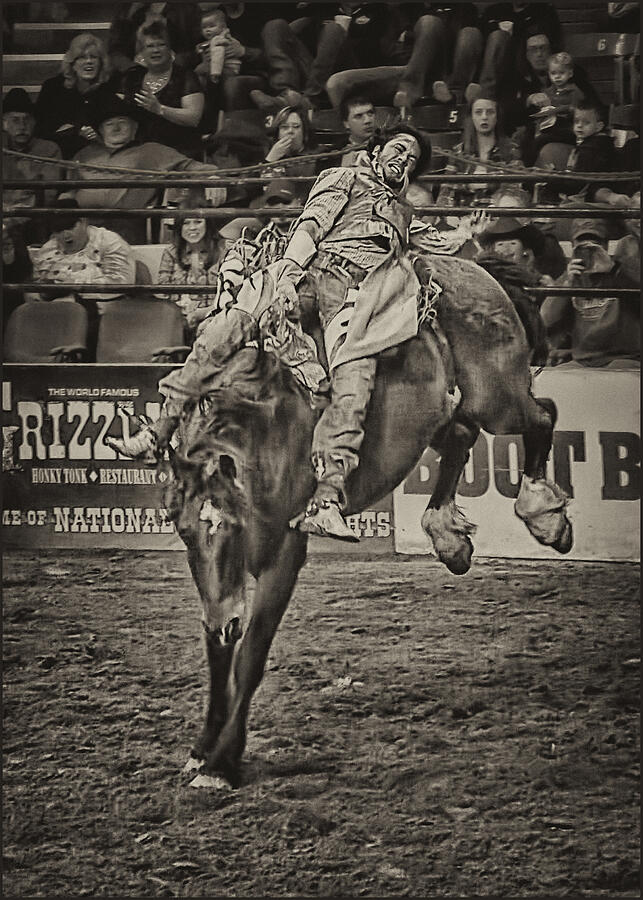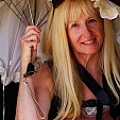
National Stock Show Bare Back Action

by Priscilla Burgers
Title
National Stock Show Bare Back Action
Artist
Priscilla Burgers
Medium
Photograph - Photography
Description
A bareback rider at a 2014 National Stock Show Pro Rodeo in Denver, Colorado strains to stay on the vigorously bucking bronco. I applied a vintage effect in keeping with the rodeos of the past.
Today's rodeo, performed by professional athletes for big stakes in huge arenas filled with cheering spectators and covered by ESPN, has come along way from its roots in the 1800's roundup camps. In the days of the ranchos, the annual roundup and branding of cattle was an occasion for a display of horsemanship and roping. When the main chores of the event called a rodeo (from the Spanish word rodear meaning "to surround") were completed, there was usually an exhibition and contest of skills by the cowboys, or "vaqueros." The skills displayed had a rich history tracing back to the great horsemanship traditions of the Spanish conquistadores. During the late 1700s and early 1800s, Spain held much of the land that is now the American West. When the missions were established, their secular activities included raising cows for America's flourishing cattle market. The need grew for skilled horsemen to handle and manage the herds. Many of the padres who ran the missions were sons of Spanish nobility. They were trained in the celebrated skills of horsemanship and roping practiced in Spain for centuries. They passed on these skills to their workers, who became known as vaqueros. When mission lands were converted to privately owned ranchos during Mexico's rule, the vaqueros found work running cattle and managing the rangelands. After America took these lands from Mexico in 1848, the vaqueros continued to work the big ranchos alongside their American counterparts, bringing with them their expertise and traditions.
After the Civil War, cattle herds spread out throughout the West and the ranks of the American cowboy grew. They worked for cattle barons driving cattle to the bustling stockyards of fast-growing towns. But this era was short lived. Railroad stock cars replaced cattle drives and open rangelands were divided up and defined by barbed wire. The demand for labor dwindled. Many a cowboy had to seek a new way of life.
There had always been informal competitions around the stockyards, where cowboys, fueled by wages and whiskey, would challenge each other to see who was the best at cutting a cow or roping. Spectators gathered around to watch the action.
In small towns throughout the west, stock horse shows (sometimes called rodeos), where cowboys could supplement their shrinking income, began to spring up on a regular basis. Clever showmen like Buffalo Bill Cody began to organize and elaborate on these events. America's fascination with the "Wild West" was turned into a business.
Those that made their living at rodeo events saw a need to standardize the events, establish rules and regulations for the safety of competitors and animals and to protect their rights. The Professional Rodeo Cowboys' Association, or PRCA, traces its roots back to 1936 when a group of cowboys staged a walkout at a rodeo at the Boston Garden. The protest resulted from the rodeo promoter's refusal to add the cowboys' entry fees to the prize money. The cowboys vowed to boycott until the entry fees were added to the prize money and judging was done with greater objectivity. The promoter, W.T. Johnson, finally relented and the Cowboy's Turtle Association was formed. The cowboys adopted the name "Turtles" for two reasons � they were slow to organize, but had finally stuck their necks out for what they believed was right. In 1945, the Turtles changed their organization's name to the Rodeo Cowboys' Association, which in 1975 became the PRCA.
With more than 170,000 fans attending the National Finals Rodeo in Las Vegas and more than 13 million viewers tuning into the finals on ESPN, rodeo is more popular and competitive than ever
The standardized events that now characterize rodeo are bareback riding, steer wrestling, team roping, saddle bronc riding, calf roping and bull riding. Many rodeos also include barrel racing, a sport that is dominated by female equestrians.
Rodeo has become a sport distinctly different from its stock horse roots. Today's stock horse shows revolve around the disciplines of reining, reined cow horse and cutting, and usually include amateur riders as well as professional trainers.
SOLD
- A face mask to a buyer in Eagle, NE on 8/9/2021. Thank you!
- A face mask to a buyer in Knoxville, TN on 10/19/2020. Thank you!
- A face mask to a buyer in Eagle, NE on 9/12/2020.
- A face mask to a buyer in Hiram, GA on 8/19/2020.
- A face mask to a buyer in Wailuku, HI on 8/4/2020.
FAA Featured Photo:
Beauty Group-02/05/2014
FAA Featured Photo:
Collectors Treasures Group-02/05/2014
FAA Featured Photo:
Your Favorite Artwork Group-02/05/2014
FAA Featured Photo:
Signs Group-02/06/2014
FAA Featured Photo:
Art From the Past Group-02/08/2014
FAA Featured Photo:
Your Best Work Group-02/08/2014
FAA Featured Photo:
Our 4-Legged Friends Group-02/08/2014
FAA Featured Photo:
Sensational Animals - Majestic Horse Group-02/16/2014
FAA Featured Photo:
Comfortable Art Group-02/20/2014
FAA Featured Photo:
Rock the Sales Group-03/24/2014
Uploaded
February 4th, 2014
Statistics
Viewed 845 Times - Last Visitor from Fairfield, CT on 04/18/2024 at 10:39 PM
Embed
Share
Sales Sheet
Comments (5)

Greta Corens
Another fabulous performance! CONGRATULATIONS! Your stunning image is now featured in the "Majestic Horses" theme of the highly viewed SENSATIONAL ANIMALS group. You are invited to promote this image on the discussion thread. http://fineartamerica.com/groups/sensational-animals-.html?tab=overview L/F























































